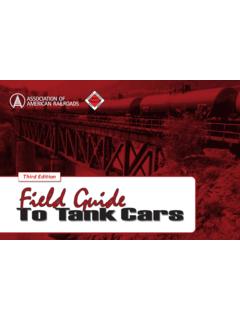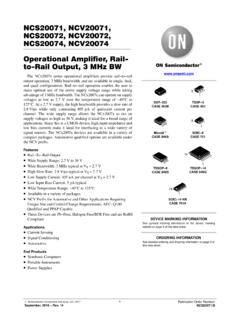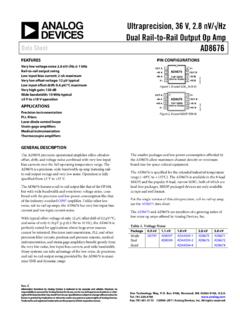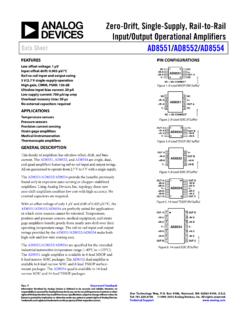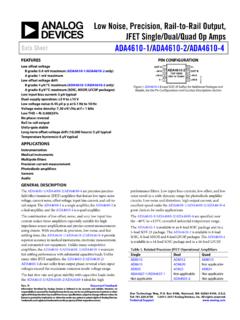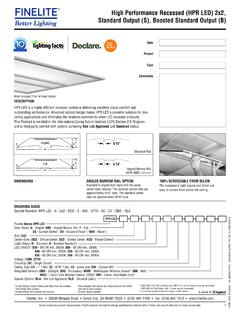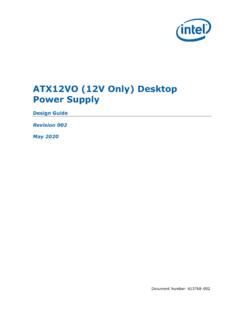Transcription of Railroad 101
1 Railroad 101 April 2022 / Sign up for AAR s newsletter at From one end of the country to the other, America is connected by the best freight rail system in the world. The seven large Class I railroads, working with hundreds of smaller railroads and tens of thousands of rail customers, deliver economic growth, support job creation, and provide crucial environmental benefits today while preparing to meet the freight transportation challenges of tomorrow. A Nationwide Network America s freight railroads are almost entirely privately owned and operated. Unlike trucks and barges, freight railroads operate overwhelmingly on infrastructure that they own, build, maintain and pay for themselves.
2 Approximately 630 freight railroads operate across the nearly 140,000-mile freight rail network. The seven Class I railroads railroads with 2019 revenue of at least $505 million account for around 68% of freight rail mileage, 88% of employees, and 94% of revenue. Each Class I Railroad operates in multiple states over thousands of miles of track. Non-Class I railroads (also known as short line and regional railroads) range in size from tiny operations handling a few carloads a month to multi-state operations close to Class I size. Together, they provide a safe, efficient and cost-effective transportation network that reliably serves customers and the nation s economy.
3 Powering American Life From the food on our tables to the cars we drive, freight rail is part of an integrated network of trains, trucks and barges that ships around 61 tons of goods per American every year. Railroads carry enormous amounts of finished goods and raw materials. Just a few examples: Intermodal: The movement of shipping containers and truck trailers by rail has been the fastest growing major rail traffic segment over the past 25 years. If you find something on retailers shelves, there is a good chance railroads moved it. Energy: Railroads safely move commodities such as crude oil, ethanol and coal to help meet America s energy needs. Coal delivered by rail to power plants for electricity generation and to ports for export is the single highest-volume commodity carried by rail .
4 Chemicals: America s freight railroads are continuing to meet the growing demands of chemical producers by transporting the chemicals that make modern life possible. These include moving fertilizers to farmers, plastic resins to auto parts producers, caustic soda to pulp and paper manufacturers, and countless other chemical products to intermediaries and end users throughout the and the world. Key Takeaway America s privately-owned freight railroads are the most productive and cost-effective in the world, connecting consumers and businesses across the country and the world while benefitting the environment and promoting safety. April 2022 / Sign up for AAR s newsletter at The Right Track for Economic Growth America s freight railroads connect producers and consumers across the country and the world, expanding existing markets and opening new ones.
5 Vital Employer: In 2020, Class I freight rail employee compensation, including benefits, averaged approximately $135,700 per year, 64% more than the average employee. Critical to the Economy: An October 2018 study from Towson University s Regional Economic Studies Institute found that, in 2017 alone, the operations and capital investment of America s major freight railroads supported approximately million jobs (nearly eight jobs for every Railroad job), $219 billion in economic output and $71 billion in wages. Railroads also generated nearly $26 billion in tax revenues. In addition, millions of Americans work in industries that are more competitive in the tough global economy thanks to the affordability and productivity of America s freight railroads.
6 Trade Connecter: Without railroads, American firms and consumers would be unable to participate in the global economy anywhere near as fully as they do today. International trade accounts for around 35% of rail revenue, 27% of rail tonnage, and 42% of the carloads and intermodal units railroads carry. Affordable & Reliable Optimizing operations has resulted in greater capacity, reliability and productivity across the rail network while delivering record performance and service levels. Efficiency and productivity that improve the cost-effectiveness of rail benefit rail customers. In fact, the affordability of freight rail saves rail customers (and, ultimately, American consumers) billions of dollars each year and enhances the global competitiveness of products.
7 Average rail rates (measured by inflation-adjusted revenue per ton-mile) are 44% lower today than in 1981, meaning the average rail shipper can move much more freight for around the same price it paid more than 35 years ago. Investing for the Future As America s economy grows, the need to move more freight will grow too. The Federal Highway Administration forecasts that total freight shipments will rise from an estimated billion tons in 2018 to billion tons in 2040 a 30% increase. Railroads are getting ready today to meet this challenge. Large Investments: From 1980 to 2020, America s freight railroads spent nearly $740 billion their own funds, not taxpayer funds on capital expenditures and maintenance expenses related to locomotives, freight cars, tracks, bridges, tunnels and other infrastructure and equipment.
8 That is more than 40 cents out of each revenue dollar. Railroads spend around 19% of revenue on capital expenditures, six times more than the average manufacturer. April 2022 / Sign up for AAR s newsletter at Always Looking to Improve Safety Freight railroads holistic approach to safety encompasses ongoing substantial investments, comprehensive employee training, innovative technologies and cooperative community outreach. Virtually every aspect of rail operations is subject to safety oversight by the Federal Railroad Administration (FRA), from track, equipment and facility inspections to employee certification and operating regulations. Railroads are also subject to oversight by the Occupational Safety and Health Administration, the Pipeline and Hazardous Materials Safety Administration and the Department of Homeland Security.
9 Safe & Getting Safer: The last decade has been the safest ever for the industry. Between 2000 and 2021, the train accident was down 33% and between 2000 and 2020, the hazmat accident rate was down 60%, The rail employee injury rate in 2020 was an all-time low. Keeping Employees Safe: Railroads today have lower employee injury rates than most other major industries, including trucking, airlines, agriculture, mining, manufacturing and construction even lower than food stores. New Technologies: Railroads are constantly developing and implementing new technologies to address safety challenges. Just a few examples: inspection stations trains pass through without having to slow down.
10 Positive Train Control (PTC), which helps reduce certain types of human-caused errors; sophisticated detectors along tracks that identify defects on passing rail cars; ground-penetrating radar that identifies problems below ground, such as excessive moisture, that could destabilize track; and specialized rail cars that use sophisticated instruments to identify defects in tracks. Policymakers should provide a regulatory environment that incentivizes industry to constantly develop innovative technologies like these that will further improve rail safety and enhance rail operational efficiency. Essential to a Greener, Less-Congested Future Railroads are the most fuel-efficient way to move freight and are well ahead of other modes of transportation when it comes to limiting greenhouse gas emissions, increasing fuel efficiency and reducing their carbon footprint.




